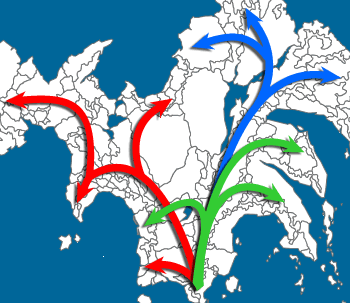Into Lyrast
According to the Calendar of Lyrásti Reckoning, 500 years passed between the appearance of the Yrūn and the establishment of their first Empire, Urzar (ca. 550 LR). During this same period, the Yrūn spread far, wide, and quickly into the Lyrásti mainland.Circa 1 – 500 LR. The Yrūni tribes expand into the Ancient Land. The Onnō establish the first Yrūni civilization in southern Lyrast and lands farther East. The Nāzar are given passage through Dwürdèni lands and claim the frozen reaches of northern Lyrast. The Vuldir explore the western shores, claiming southwest Lyrast and lands from the Cadìrili Coast to the Sea of Odìmis. Enemies are found among the Eylfāe and Ikítikírittìk.
Onnō Culture
The Onnō did not travel far, settling in the lands of southern Lyrast. It is assumed that the Onnō were the most powerful and/or numerous of the Yrūnyr because the others had to venture further afield to find lands that they could settle.
Standing at the center of the capital of Tolōmir (i.e., Volórin) stands a weathered stone obelisk believed to have been erected by Onnō craftsmen in 835 LR. The Obelisk of Volórin is significant for two reasons. First, it bears the oldest Yrūni writing known, if you discount the indecipherable carvings of Emer. Second, it outlines the Calendar of Lyrásti Reckoning which is generally considered to be an Onnō creation. The similarities between the Lyrásti and Emeréni calendars suggests prehistoric (i.e., Emeréni) teachings were still available at this time.
- March of the Ikítikírittìk (e.g., Ikìbri Massacre, First Battle of Urzar)
Nāzar Culture
The Nāzar were a hearty people that ventured far away from their southern brethren. These people traveled long and hard through bleak lands and mountainous coasts of eastern Lyrast. The earliest settlement of the Nāzar is Isìdvir (founded ca. 260 LR), now part of southern Sarask. If Nāzàri settlements existed south of this remote locale, none remain. Though Nāzar Culture survived over much of northern Lyrast, their people were very widespread and their language changed greatly from place to place. In the northeastern corner of Lyrast the Nāzar founded Kȳrim (ca. 320 LR), a kingdom that included present-day Harlor and Orval. In the north central Lyrast they founded Nuzhir (ca. 355 LR), a kingdom that included present-day Kitàlsk, Varsta, Zirak, and the eastern shores of Odìmis. To this day the people of these areas share common traditions and a similar language, though the languages become more varied the further one distances themselves from Isìdvir.
Vuldir Culture
The Vuldir took a westerly route, following the coastline into the eastern reaches of Vulmùra. The migration might have gone further if not for an obstacle called the Great Anahl, the heart of the Eylfāe presence in the World of Teréth End. Although there are no records of this first meeting, it was likely bloody. Many Vuldìryr settled near Kaldàkul (ca. 410 LR) as the Eylfāe began “construction” of the Great Thorn Barrier. Some of the Vuldir sought a northern passage but finding none decided to settle along the Sea of Odìmis (ca. 440 LR).
